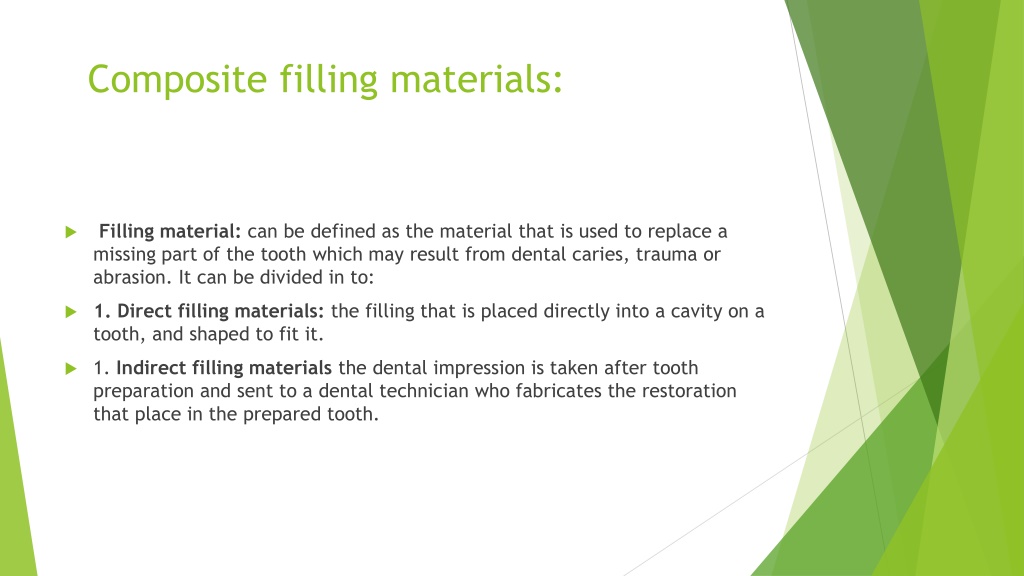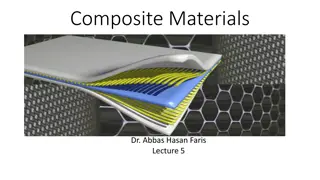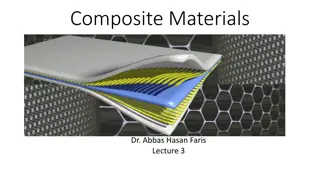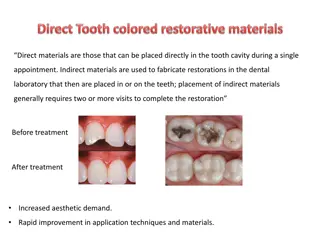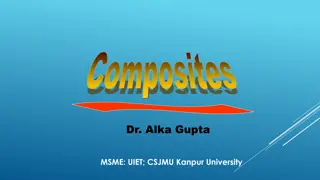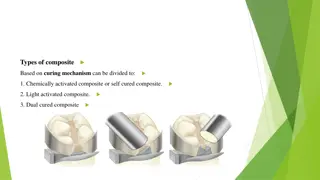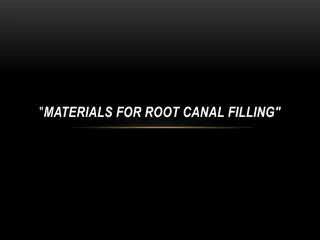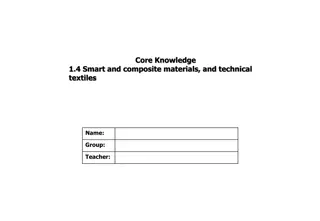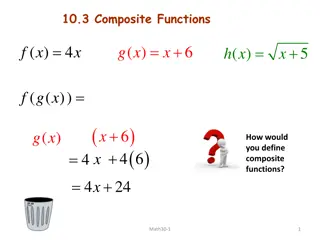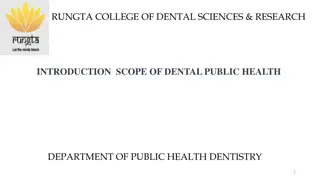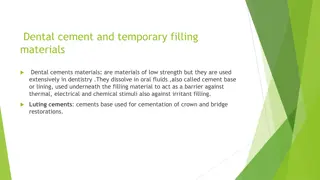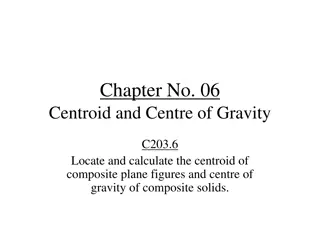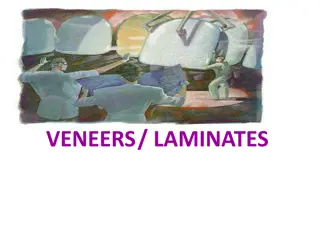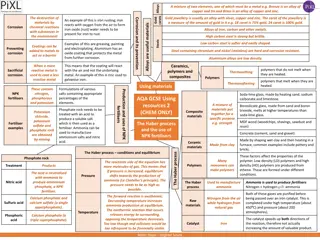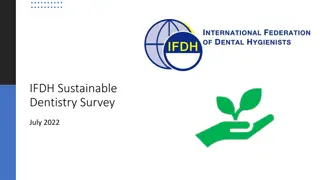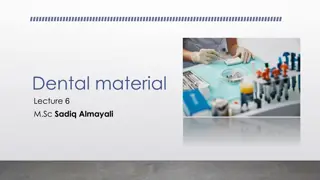Understanding Composite Filling Materials in Dentistry
Composite filling materials are used to replace missing parts of a tooth caused by dental issues. The materials can be direct or indirect, each with specific requirements for ideal performance. Metallic and non-metallic classifications exist, with considerations such as thermal insulating properties, mechanical strength, adherence to tooth structure, and more. Silicate cements, once popular but now less used, have advantages and disadvantages that impact their utility in modern dental practices.
Download Presentation

Please find below an Image/Link to download the presentation.
The content on the website is provided AS IS for your information and personal use only. It may not be sold, licensed, or shared on other websites without obtaining consent from the author. Download presentation by click this link. If you encounter any issues during the download, it is possible that the publisher has removed the file from their server.
E N D
Presentation Transcript
Composite filling materials: Filling material: can be defined as the material that is used to replace a missing part of the tooth which may result from dental caries, trauma or abrasion. It can be divided in to: 1. Direct filling materials: the filling that is placed directly into a cavity on a tooth, and shaped to fit it. 1. Indirect filling materials the dental impression is taken after tooth preparation and sent to a dental technician who fabricates the restoration that place in the prepared tooth.
Requirement of an ideal Filling material: Requirement of an ideal Filling material:- 2. Working time should be sufficiently long, to enable manipulation and placement of material before setting. 3. Setting time should ideally be short for comfort and convince of both the patient and clinician. 4. The material must withstand large variation in PH and a variety of solvents which may be taken into mouth in drink food stuffs and medicaments. 5. Filling should be good thermal insulator, protecting the dental pulp from the harmful effect of the hot and cold stimuli (low thermal diffusivity). 6. Materials should have values of coefficient of thermal expansion similar to those of enamel and dentine.
7. Metallic material should not undergo excessive corrosion, or be involve in the development of electrical currents which may cause" Galvanic pain. 8. Should have satisfactory mechanical properties to withstand the force applied, abrasion resistance, compression and tensile strength, modulus of elasticity. 9. It should adhere well to the tooth walls and seal the margins to prevent ingress of fluid and bacteria. 10. It should be harmless to the operator and to the patient and should not be irritant to dental pulp and soft tissue. 11. It should be radiopaque. 12. It should bacteriostatic and anticariogenic. 13. It should be easily polished.
Classification of filling materials: 1. Metallic a. Amalgam. b. Direct Gold filling. c. Indirect cast restorations. 2. Non metallic which include a. Polymeric Unfilled resin (acrylic) Filled resin (composite, compomers) b. Non polymeric Silicate cement Glass ionomers cement
Other classifications: 1. Anterior filling material (tooth colored filling). 2. Posterior filling material.
Silicate cements: It supply as powder and liquid with Fluoride release (less chance for caries development).its Advantages 1. Easy manipulated. 2. Anti cariogenic: fluoride release 3. Good insulator. Silicate not used now a day because of its disadvantages as: 1. Pulpal irritation due to low pH (5-3.5) 2. Brittle and has poor mechanical properties. 3. Shrinkage on setting. 4. Discoloration. 5. High solubility and disintegration
Unfilled acrylic resin: The unfilled acrylic possessed improved resistance to solubility and had no problems with dehydration (better than Silicate cements) although staining was a problem, These materials currently being used for temporary restorations. Nowadays it is replaced by the composite resin; the undesirable properties of unfilled acrylics were: 1. large dimensional change on setting and with temperature, resulting in percolation of saliva at margins which cause recurrent caries 2. low mechanical strength and stiffness
3. low wear resistance (easily abraded) 4. Problems with recurrent decay and stains due to leakage of oral fluids at the margins of the restoration. 5. irritant to pulp
Composite materials : - The term composite may be defined as a compound of two or more distinctly different materials with properties that are superior or intermediate to those of the individual constituents. In dentistry, the term resin composite refers to a reinforced polymer matrix materials used as restorative materials. The proper term is polymer matrix composite or resin composite. It has higher mechanical properties than of acrylic filling and of silicate cement filling. Modern composite materials have excellent esthetics that mimics the natural teeth and excellent durability, wear-resistance, high mechanical properties for stress bearing areas (used as anterior and posterior filling materials)
Composition: A resin composite is composed of four major components: 1. Organic resin matrix. ( BIS- GMA or urethane dimethacrylate) 2. Inorganic filler particles (Quartz, colloidal silica glasses or ceramic containing heavy metals. 3. Coupling agent (organo silanes). 4. The initiator-accelerator system. Also they contain 5. Hydroquinone - inhibitor to prevent premature polymerization 6. UV absorber - to improve color stability 7. Opacifiers - e.g. titanium dioxide and aluminum oxide. 8. Color pigments - to match tooth color
Organic resin matrix:- The nature of it may alter slightly from one product to another, essentially The monomers used for the resin matrix are dimethacrylate compounds. Its properties were superior to those of acrylic resins. The two monomers that have been commonly used are (BIS-GMA) and urethane dimethacrylate (UDMA). Both contain reactive carbon double bonds at each end that can undergo addition polymerization initiated by free- radical initiators. Both of BIS-GMA and UDMA are viscous and sticky so, TEGDMA 'triethylene glycol dimethacrylate' with low molecular weight added as a dilute monomer to control the consistency of composite paste.
Inorganic Filler particles: Fillers have been obtained by grinding minerals such as quartz, glasses, or sol-gel derived ceramics. Composite resins use 3 types of fillers: 1. Ground quartz filler: They are obtained by grinding or milling the quartz. They are mainly used in conventional composites. They are chemically inert and very hard. This make restoration more difficult to polish and can cause abrasion of opposing teeth and restoration. The quartz filler is harder than the glass filler.
2. Colloidal silica: Referred to as microfillers. They are added in small amount (5 wt %) to modify the paste viscosity. Colloidal silica particles have large surface area thus even small amount of micro fillers thicken the resin. It used in microfilled composites. 3. Glasses / ceramics containing heavy metal: There filler provide radiopacity to resin restoration. ex. Barium ;Zirconium. The most commonly used is barium glass. It is not as inert as quartz some barium may leach out.
The Coupling agents: the composite to have successful properties, a good bond must form between the inorganic filler and the organic resin, The most commonly used coupling agents are organosilanes (often referred to as silane). It is applied to the inorganic filler particles to surface-treat the fillers before being mixed with the monomer. They called coupling agents, because they bond the filler particles to the resin matrix. This allows the more plastic resin matrix to transfer stress to stiffer filler particles. Function of coupling agents.
1. They improve the physical and mechanical properties of resin 2. They prevent water from penetrating the filler - resin interface. (Micro leakage of fluids into filler resin interface led to surface staining). 3. Prevent the filler from being dislodged from the resin matrix.
The initiator-accelerator system: is to polymerize and cross-link the system into a hardened mass. The polymerization reaction can be activated by light- activation, self-curing (chemical activation), and dual curing (chemical and light-curing).
Properties of the composite 1. Low polymerization shrinkage 2. Low water sorption 3. Coefficient of thermal expansion closer to tooth structure 4. High fracture resistance 5. High wear resistance 6. High radiopacity 7. Good bond strength to enamel and dentin (by using bonding) 8. Good color match to tooth structure 9. Easy to manipulation 10. Easy of finishing and polishing
